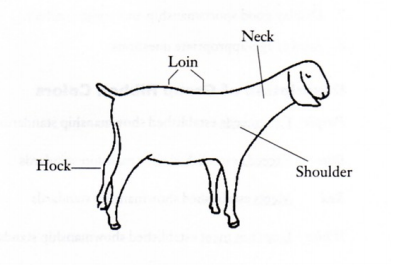General Knowledge Information
Taking part in a 4-H Livestock Project can be exciting and rewarding experience. Through the meat goat project you are given the opportunity to learn about taking care of an animal, working with other young people, and developing sound judgment skills. When beginning with any new project or activity it is a learning experience for all involved. More knowledge is gained by taking part than by watching others.
Below are the most important aspects that you should know about your project animal to make your learning experience complete. Remember that the more you work with the meat goat project the more knowledge that you can gain.
Items to Learn and Know
- Breed of animal exhibited and/or other breeds in the class
- Date of birth / age of animal
- Current weight of animal
- Feeding (what and when)
- Gender of animal
Body Parts to Know
- Hock
- Neck
- Loin
- Shoulder
Basic Equipment to Know
- Rope halter
- Neck chain
- Collar
- Hoof trimmer
- Clippers
Meat Goat Showmanship Danish Standards for 5 and 6 Year Old Exhibitors
Showmanship provides the opportunity to show an animal to the best of your ability. You are judged on how well you show your animal. Judging for showmanship does not include the conformation of the animal. Practice and planning will help you improve your showmanship skills. The Meat Goat Showmanship factsheet offers more in-depth coverage of showmanship styles and care of the project animal.
Below are the showmanship standards for 5 and 6 year old youth. These standards are established to provide youth with guidelines of the more important aspects of developing showmanship skills.
Showmanship Skills to Develop
- Lead and control animal from the animal's left side.
- Learn to follow directions from the ring steward and/or judge.
- Keep good eye contact with the judge.
- Attempt to set the animal up in the proper position.
- Wear appropriate show ring attire.
- Have animal clean and presentable.
- Display good showmanship and polite conduct.
- Answer age-appropriate questions.
Description of Group Ribbon Colors
Purple: Far exceeds established showmanship standards
Blue: Exceeds established showmanship standards
Red: Meets established showmanship stanards
White: Does not meet established showmanship standards
Special acknowledgment is extended to the following individuals for their valuable contribution to the development of this educational material. Frank Bolick, Watauga County; J.D. Brooks, Buncombe; Kathy Bunton, Alexander County; Walter Earle, Wilson County; Michael Hobbs, Buncombe County; Brinton Hopkins, PhD, Department of Animal Science; Ronald Huges, Johnson County; Kenneth Vaughn, Iredell County.
Publication date: Feb. 1, 2003
Reviewed/Revised: May 3, 2022
N.C. Cooperative Extension prohibits discrimination and harassment regardless of age, color, disability, family and marital status, gender identity, national origin, political beliefs, race, religion, sex (including pregnancy), sexual orientation and veteran status.


